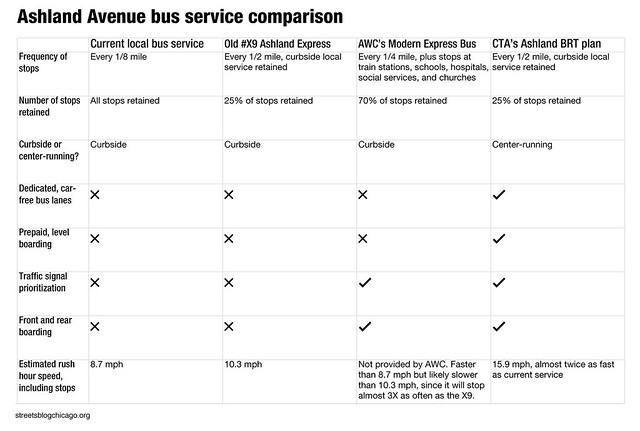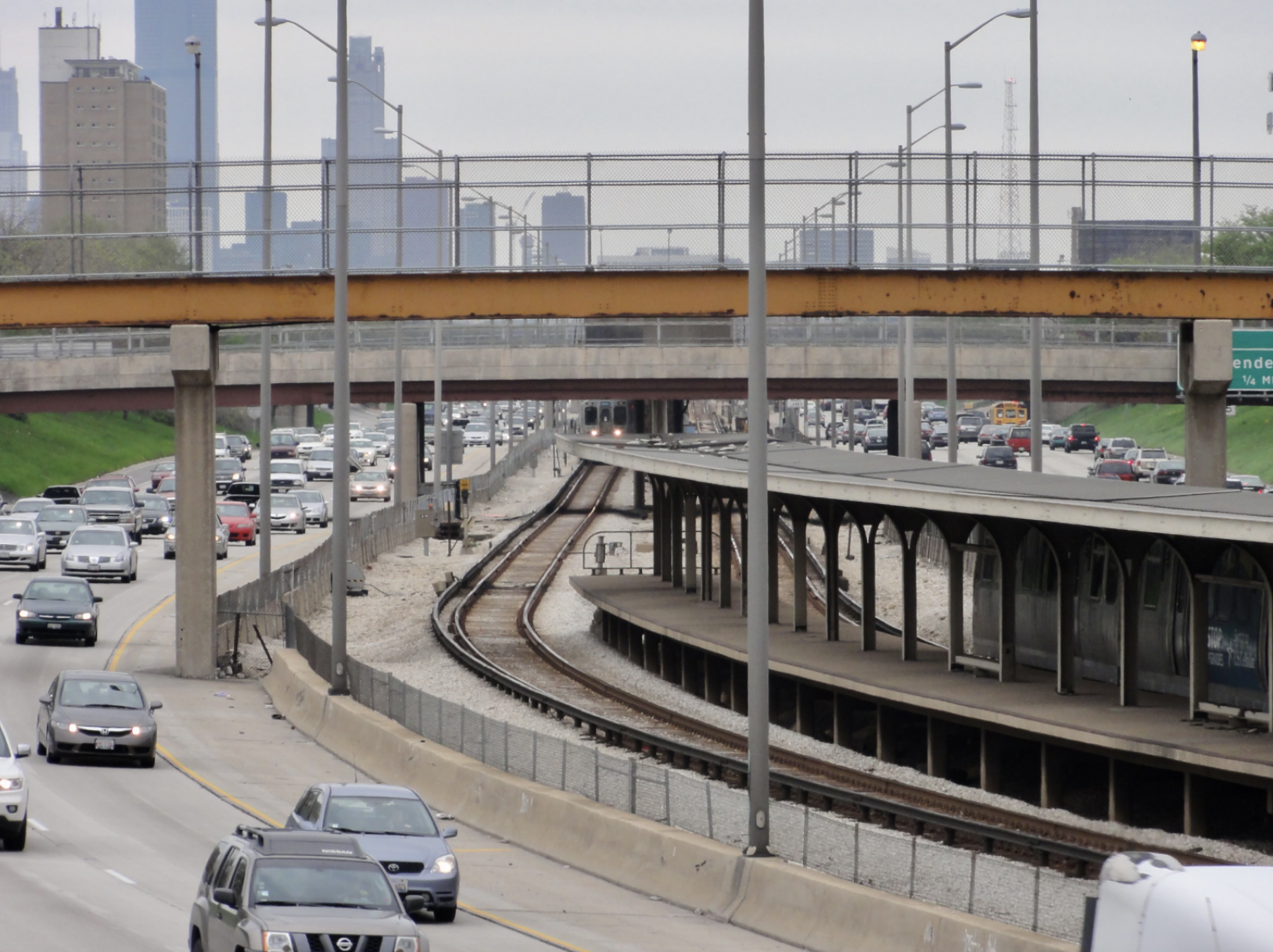Why the Anti-Bus Rapid Transit Arguments Don’t Make Sense
6:36 PM CDT on August 29, 2013
I gotta hand it to the folks from the anti-bus rapid transit group the Ashland-Western Coalition, they’re nothing if not tenacious. On Wednesday they held another public meeting at Orlando Glass and Trim, 641 North Ashland Avenue, to discuss their strategy to derail the CTA’s plan to create fast, reliable bus rapid transit service on Ashland. Another meeting will be held this Friday, August 30, at 1 p.m. at First Baptist Congregational Church, 1613 West Washington. RSVP to AshlandWesternCoalition[at]gmail.com if you want to attend, but it’s probably best not to tell them you heard about the meeting here.
The coalition’s main beefs against the BRT plan are that it will involve converting two of the four travel lanes on Ashland to dedicated, car-free bus lanes, as well as the prohibition of most left turns. I’ll address their concerns about these changes later in this post. Claiming to be transit advocates, they have put forth a watered-down alternative proposal, dubbed “Modern Express Bus” service. This would include some BRT-style features like fewer stops, traffic signal prioritization, and front-and-rear bus boarding.
However, if you look at the chart above, you’ll see that MEB would essentially be a return to the old, slow #X9 Ashland Express, plus a bit of window dressing. While the X9 made 75 percent fewer stops than the local buses, it crawled along at 10.3 mph during peak hours, only a bit faster than the 8.9 mph locals, because it got stuck behind the glut of private cars. Despite the MEB proposal's BRT-like features, the MEB buses would only make 30 percent fewer stops than the locals, stopping almost three times as often as the X9, so they would likely be even slower than the old express bus. It’s obvious the coalition’s main concern isn’t improving transit but rather but rather avoiding having to change their driving habits.
I wasn’t able to attend yesterday’s meeting, but let’s take a look at the coalition’s arguments as reported in DNA Info by Mike Brockaway, who also writes the blog The Expired Meter. He’s an often-insightful commentator on local parking policy, but it must be noted that his writeup for the news site, probably unintentionally, shows some anti-BRT bias.
For example, he writes that the meeting included "a presentation outlining the negative impact the city's plan on the street and neighborhoods, an outline of the group's alternative proposal and what the group needs to do next to succeed.” This phrasing assumes that BRT will have a harmful effect on communities. In reality, besides cutting travel times for bus riders, the plan will result in safer, more pleasant conditions for pedestrians. Judging by the experience of other cities, it will also lead to more vibrant retail districts and higher property values.
Also, like almost all recent articles about BRT in the local media, Brockaway’s piece include quotes from coalition members and other anti-BRT residents complaining about the plan, with responses from CTA officials. This creates a David-and-Goliath narrative, suggesting a struggle between community members and the city bureaucracy. No airtime is given to the dozens of businesses and organizations that have signed on as official supporters of the plan, let alone the 1,700-plus residents who have signed an Active Transportation Alliance petition supporting the plan or contacted their aldermen to endorse it.
Now let’s take a look at the arguments put forth at Wednesday’s meeting, held in the glass shop's parking lot and led, once again, by Roger Romanelli, who has repeatedly denied being the leader of the coalition. "We want the best public transit for our city," Romanelli said at the event. See the above chart again for a reminder of how this isn’t true.
"I'm confident an hour after this is done everyone in charge will realize 'Oh my god, what have we done?'" said Jay Goltz of the Goltz Group. "To suggest it won't have an impact on business is crazy." BRT will indeed have an impact on business, a positive one, by making it much easier for employees and customers to get to industrial and retail businesses by bus, as well as improving pedestrian access.
Romanelli and others worried that the conversion of car lanes to bus lanes would force traffic onto residential streets. While it’s true that there will be 50 percent less capacity for motor vehicles on Ashland, the predicted Carmageddon is not going to materialize. On New York City’s First Avenue, where two out of five travel lanes were converted to a dedicated lane for Select bus service and a protected bike lane, the average car speed, as measured by GPS in taxis, actually increased. Meanwhile bus speed and ridership also rose and the crash rate fell.
There would be an increase in traffic jams on Ashland if the same number of people who drive there now continued to do so with fewer lanes. But once people are given the option of taking a bus that’s virtually as fast as driving, minus the costs and headaches, many motorists will choose to switch modes. Other drivers will choose alternate routes, like Western Avenue, Damen Avenue, Halsted Street and the Kennedy Expressway.
There’s also the phenomenon of traffic evaporation, the fact that when you eliminate space for cars, you also take away the demand for it because people tend to make fewer unnecessary trips. For example, converting car lanes to bus lanes has been a core part of Paris's traffic reduction strategy, and they've made huge progress. Since there will be fewer cars on Ashland, the CTA is projecting that vehicle speeds will only be reduced by 4.9 percent.
As for the left-turn prohibition, the city is planning for a few exceptions at locations like expressway entrances, but it won’t be hard for delivery trucks and other vehicles to plan their routes so as to eliminate left turns. In fact, delivery services like UPS already have a policy of avoiding left turns so as to save time and fuel.
"The CTA has not taken every measure they can to modernize the Ashland buses - we deserve to see that," Romanelli said at the meeting. "The CTA has an obligation to improve Ashland bus service.” Although he was making an argument for implementing the anemic MEB proposal instead of city’s robust plan, his words were accurate. The CTA does have an obligation to provide the most modern, efficient bus service possible on Ashland, and that means repurposing car lanes to create BRT.
In addition to editing Streetsblog Chicago, John writes about transportation and other topics for additional local publications. A Chicagoan since 1989, he enjoys exploring the city on foot, bike, bus, and 'L' train.
Read More:
Stay in touch
Sign up for our free newsletter
More from Streetsblog Chicago
Today’s Headlines for Thursday, April 18
Roger that! Streetsblog SF editor Roger Rudick offers constructive criticism of Chicago’s downtown bike network
"There were blocks that felt very safe and very secure," he said. "But then you're immediately – voom! – disgorged into three lanes of moving traffic with no protection."
City announces $2M federal grant to address harms caused by I-290 by improving walk/bike/transit access
The Mayor's Office says the money will fund "improvements for people walking and bicycling on existing streets and paths surrounding and crossing the corridor."






